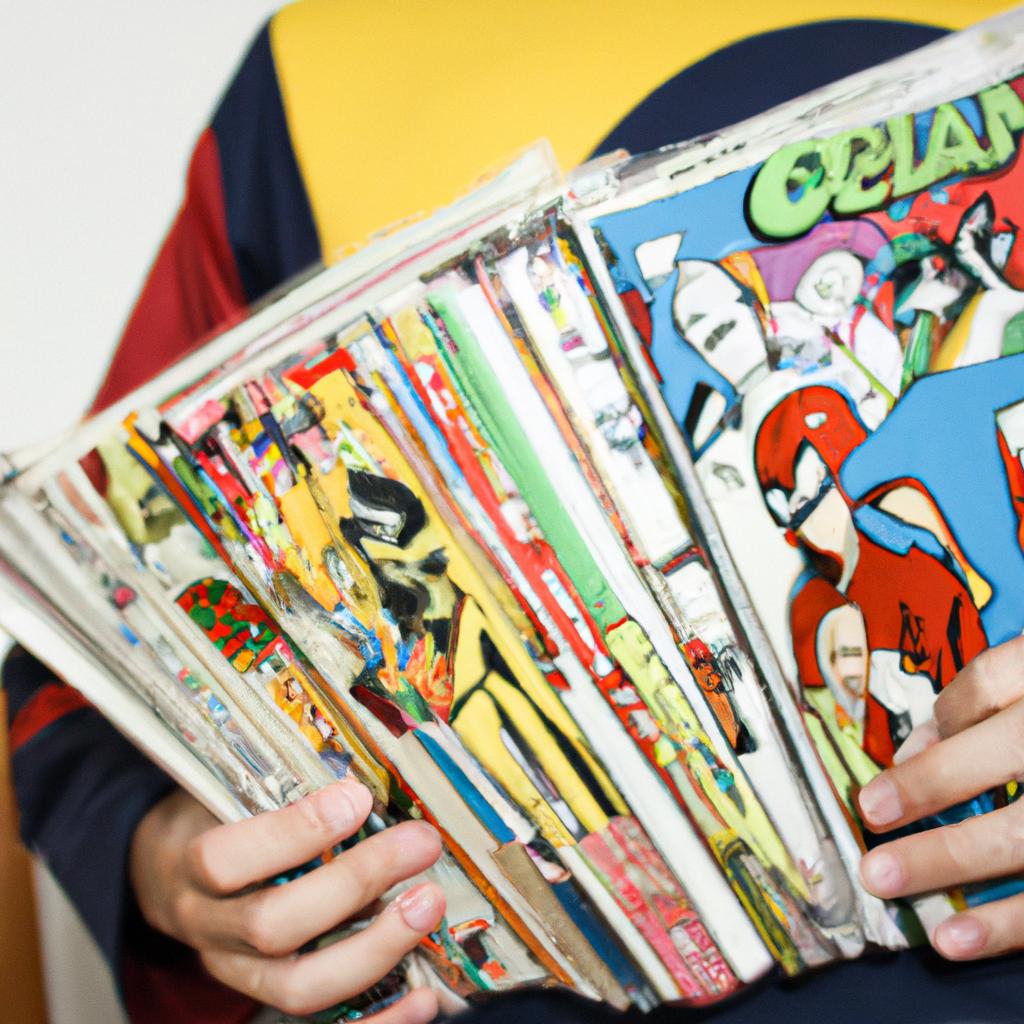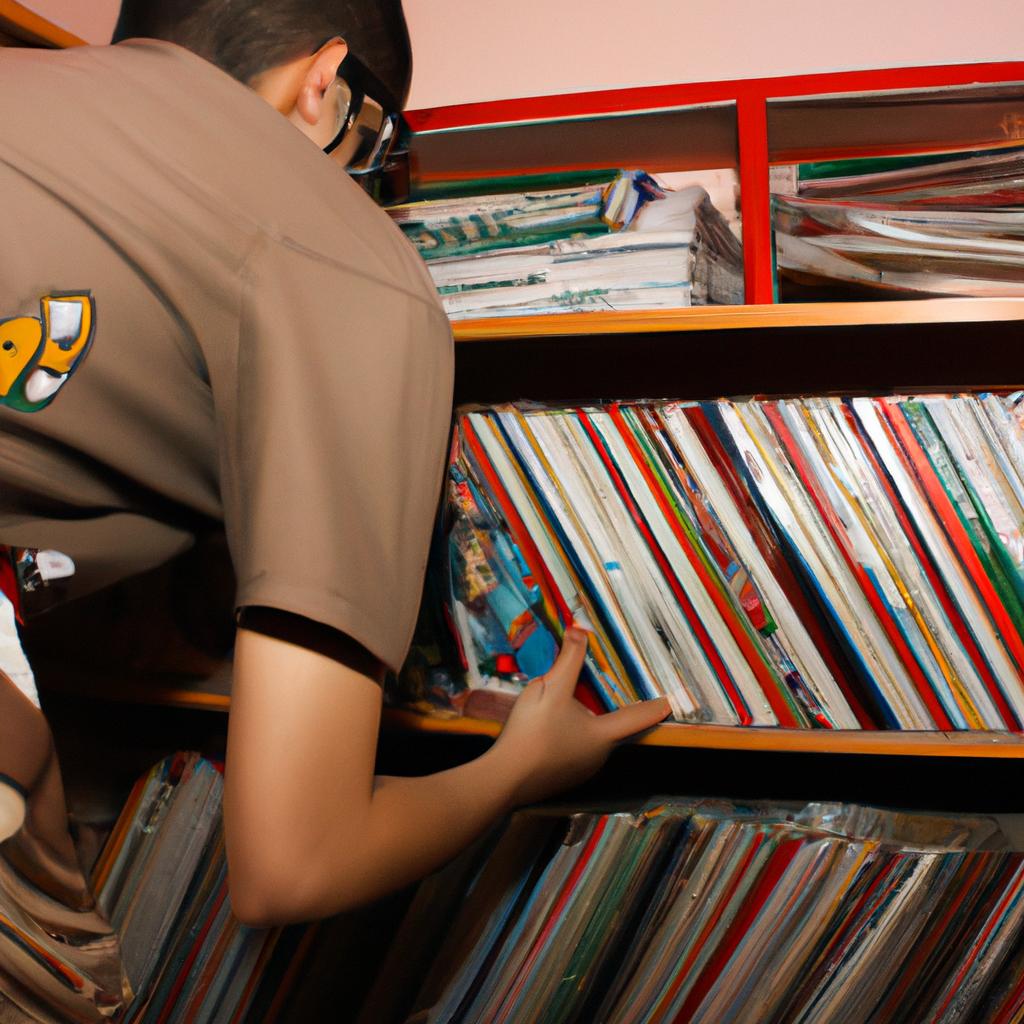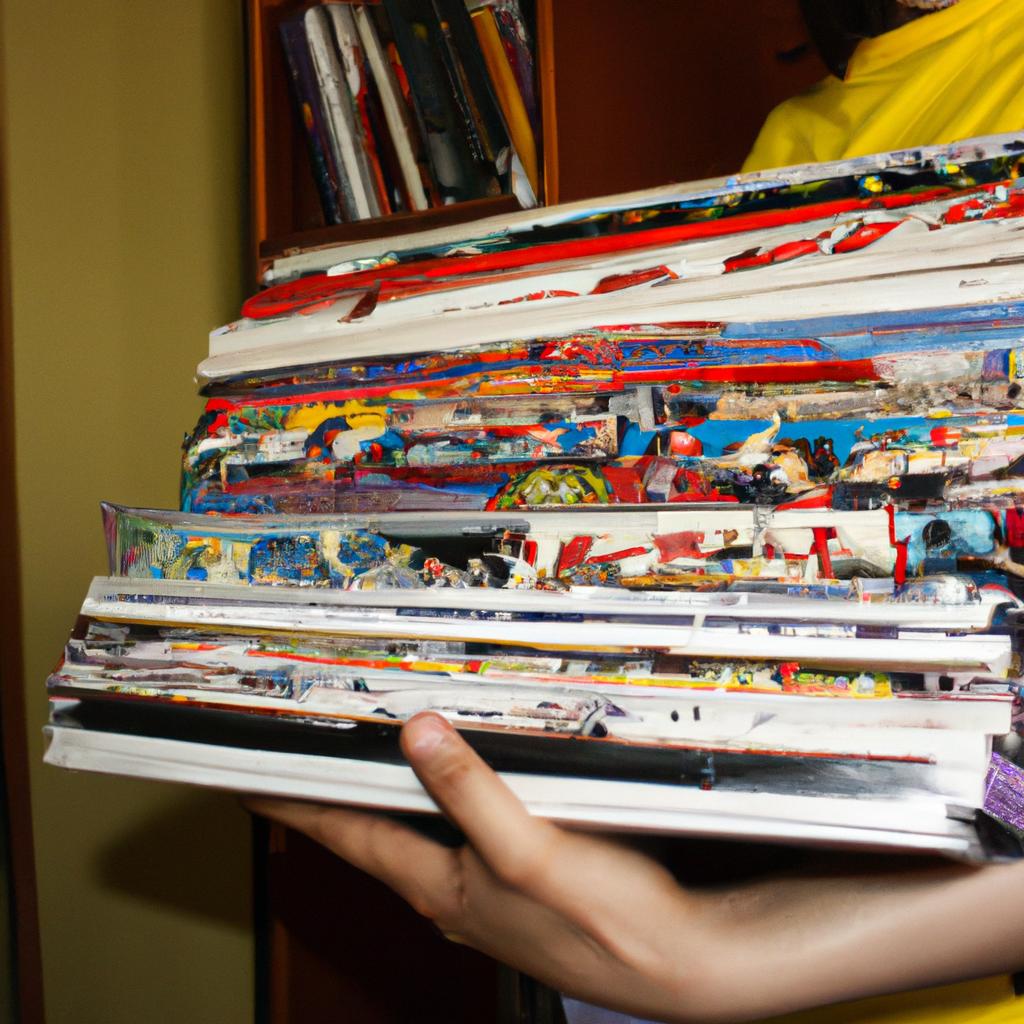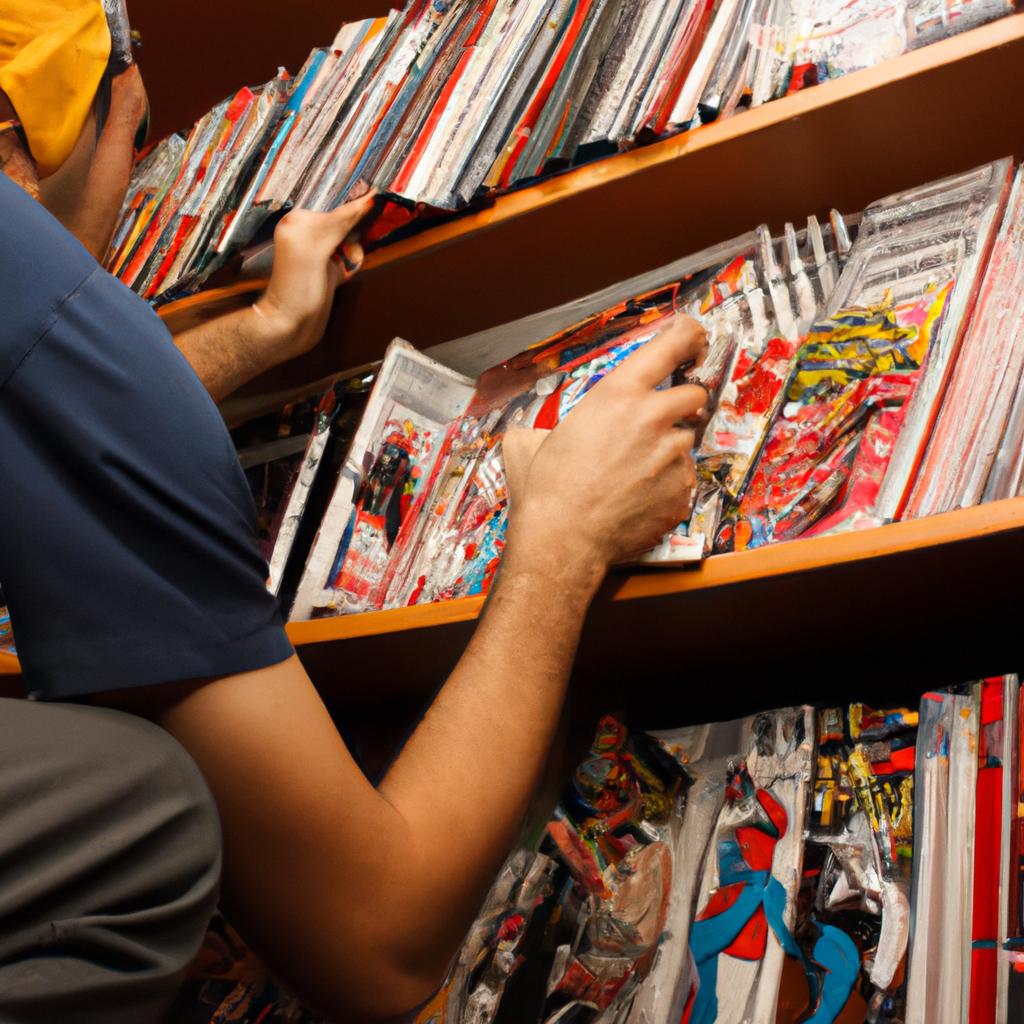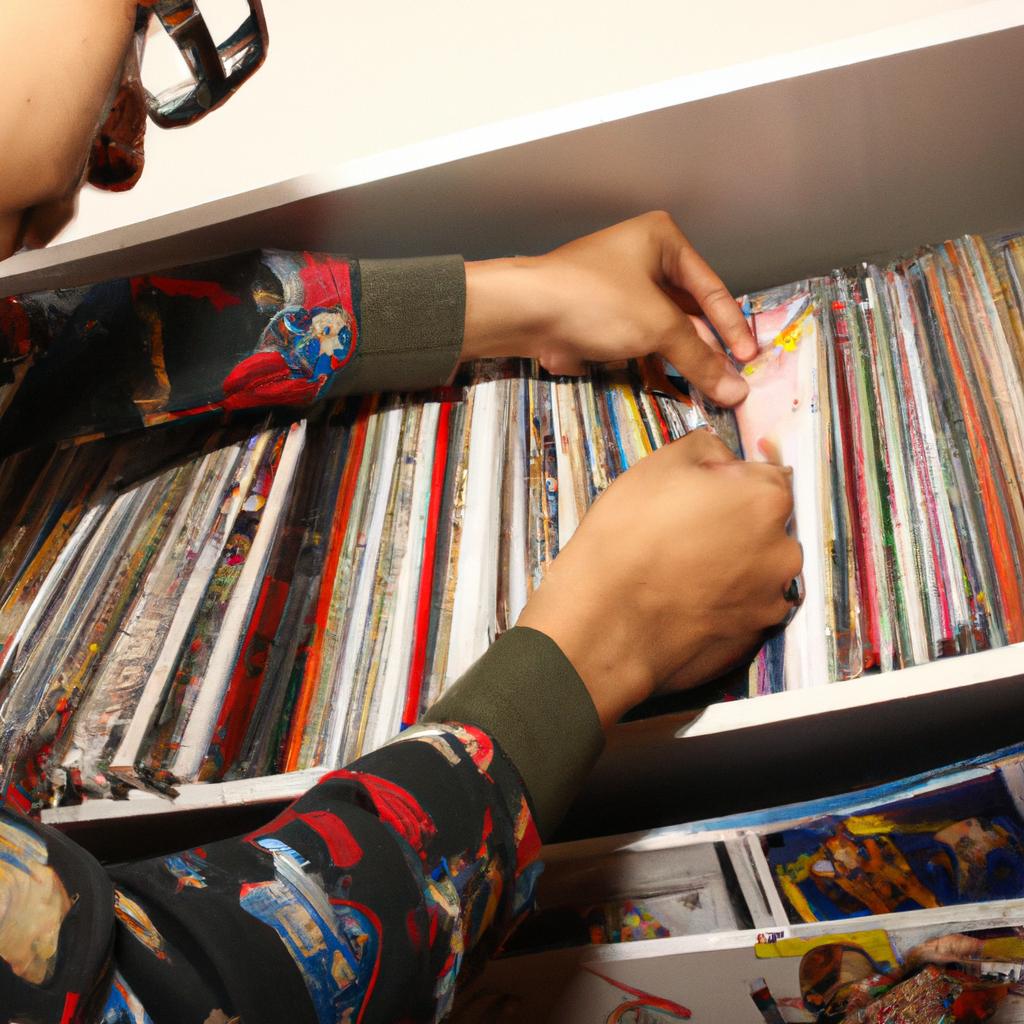Preservation and Restoration Techniques: Antiques and Collectibles in Comic Book Collecting

Comic book collecting is a popular hobby that has gained immense popularity over the years. Enthusiasts often seek out rare and valuable comic books, considering them not only as a source of entertainment but also as valuable collectibles. However, preserving and restoring these antiques poses numerous challenges due to their delicate nature. This article explores preservation and restoration techniques specific to comic book collectibles, focusing on the case study of a hypothetical vintage Spider-Man comic.
Preserving and restoring antique comic books requires meticulous attention to detail and specialized knowledge. One particular example that highlights the significance of preservation techniques is a hypothetical scenario involving a vintage Spider-Man comic from the 1960s. Imagine an avid collector stumbling upon this treasure at a flea market; its vibrant colors faded by time and pages yellowed with age. In such instances, collectors face the challenge of striking a balance between maintaining the authenticity of the piece while ensuring its longevity through careful restoration methods.
The importance of preservation in comic book collecting cannot be overstated. Without proper care, these beloved artifacts can succumb to various forms of damage such as creases, tears, color fading, or even complete disintegration over time. Therefore, understanding effective preservation and restoration techniques becomes paramount for collectors who wish to safeguard their investments and enjoy their comic book collection for years to come.
One of the first steps in preserving a vintage comic book is ensuring proper storage. Comic books should be stored in acid-free, archival-quality bags and backing boards. These materials help prevent exposure to moisture, dust, and light that can cause deterioration. It’s also essential to store them in a cool, dry place away from direct sunlight or extreme temperature fluctuations.
To address color fading, collectors can consider professional restoration techniques such as color touch-ups. However, it is crucial to consult with experienced professionals who specialize in comic book restoration to ensure ethical practices are followed. Restoration should aim to enhance the original artwork while maintaining the integrity and historical value of the comic book.
When handling antique comic books, collectors should take precautions to prevent further damage. Clean hands or using gloves is recommended to minimize contact with oils and dirt that may transfer onto the pages. Turning pages carefully from the corners with clean fingers or using acid-free page-turning tools can help prevent tears or creases.
If a vintage comic book has already suffered damage, collectors have options for restoration. Mild tears or creases can often be addressed by using archival tape or adhesives specifically designed for paper conservation. However, major repairs like reattaching detached covers or reconstructing missing pages are best left to professional conservators who possess the necessary expertise and materials.
Lastly, documenting and cataloging one’s collection is an essential aspect of preservation. Maintaining detailed records of each comic book’s condition, provenance, and any restoration work done helps establish authenticity and provides valuable information for future reference.
In conclusion, preserving and restoring antique comic books requires careful attention to detail and specialized knowledge. By following proper storage methods, consulting professional restorers when necessary, and taking precautions during handling, collectors can safeguard their investments and enjoy their treasured comic book collections for generations to come.
Importance of Preservation and Restoration
Preservation and restoration play a crucial role in the world of comic book collecting, ensuring the longevity and value of these treasured items. To illustrate the importance of preservation, let us consider a hypothetical scenario. Imagine an avid collector who stumbles upon a vintage copy of Action Comics #1 from 1938—the first appearance of Superman—while browsing through a dusty attic. Excitement fills their heart as they hold this rare gem in their hands, realizing its potential worth. However, without proper preservation techniques, this valuable piece of history may deteriorate over time, losing its appeal and diminishing its market value.
To emphasize the significance of preservation further, here are four reasons why collectors should prioritize this aspect:
- Historical Significance: Comic books offer insights into different eras, reflecting cultural shifts and societal attitudes at specific points in time. By preserving these artifacts, we ensure that future generations can study and appreciate this unique historical record.
- Cultural Heritage: Comic books are not merely entertainment; they also represent our shared cultural heritage. Preserving them allows us to pass down stories and artistic expressions to future enthusiasts, fostering a sense of continuity between past and present.
- Investment Value: For many collectors, comic books hold significant monetary value. Proper preservation techniques help maintain the condition of these collectibles, potentially increasing their investment worth over time.
- Personal Connection: Collecting comic books often stems from personal passion or nostalgia for childhood memories. Preserving these treasures helps individuals maintain a tangible connection to their own experiences and emotions associated with these beloved characters and narratives.
In addition to understanding the importance of preservation, it is essential to grasp various common techniques employed by collectors worldwide. This subsequent section will delve into specific strategies used to safeguard comic books against deterioration while maintaining their original integrity.
[Table: Common Preservation Techniques]
| Technique | Description |
|---|---|
| Acid-Free Storage Materials | Using acid-free bags, boards, and boxes to prevent yellowing and degradation caused by acid-based materials. |
| Temperature and Humidity Control | Storing comic books in a controlled environment to mitigate the effects of extreme temperatures or humidity, which can accelerate deterioration processes. |
| Proper Handling Procedures | Employing correct handling techniques such as wearing gloves to avoid oil transfer from hands onto fragile pages. |
| UV Protection | Shielding comics from direct sunlight or artificial ultraviolet (UV) light sources that can fade colors and damage paper over time. |
By recognizing the importance of preservation and familiarizing ourselves with various techniques, collectors can ensure that their beloved comic book collections retain their value while preserving these cultural artifacts for future generations.
Moving forward into the next section on common preservation techniques, let us explore how collectors actively safeguard their treasured comic book collections against potential damage.
Common Preservation Techniques
Preservation and Restoration Techniques: Antiques and Collectibles in Comic Book Collecting
Importance of Preservation and Restoration:
In the previous section, we discussed the importance of preserving and restoring comic books to maintain their historical value. Now, let us delve deeper into some common preservation techniques that can be employed to safeguard these valuable collectibles.
Common Preservation Techniques:
To illustrate the effectiveness of preservation techniques, consider a hypothetical case study involving a rare first edition comic book from the 1960s. This particular issue is highly sought after by collectors due to its limited print run and significance within the superhero genre. Without proper preservation measures, this comic book would deteriorate over time, potentially losing both monetary and cultural value.
-
Acid-Free Storage Materials: Using acid-free storage materials such as archival sleeves and boxes helps prevent degradation caused by acidic compounds present in conventional paper products. These specially designed materials create a stable environment for comic books, protecting them from yellowing or becoming brittle.
-
Temperature and Humidity Control: Controlling temperature and humidity levels plays a crucial role in preserving comics. High temperatures accelerate chemical reactions that degrade paper fibers, while excessive moisture promotes mold growth. By maintaining optimal conditions (around 68°F/20°C with a relative humidity between 40% – 50%), collectors can significantly extend the lifespan of their comic book collection.
-
UV Protection: Exposure to ultraviolet (UV) radiation can cause fading and discoloration of comic book covers and pages. Shielding collectibles from direct sunlight or using UV-blocking materials like specialized display cases or films can minimize damage caused by light exposure.
-
Proper Handling Techniques: Careful handling is essential when accessing or displaying your comic book collection. Wearing clean gloves prevents oils from transferring onto delicate surfaces, reducing the risk of smudging ink or staining pages with fingerprints.
Table: Emotional Value of Preserving Comics
| Benefit | Description |
|---|---|
| Historical Significance | Preserving comic books ensures that future generations have access to these cultural artifacts, allowing them to appreciate the history and evolution of popular culture. |
| Sentimental Attachment | Many collectors develop deep emotional connections with their comics, often associating cherished memories or personal experiences with specific issues. By preserving them, these sentimental attachments can be safeguarded for years to come. |
| Investment Value | Comic books hold significant financial value for collectors and investors alike. Proper preservation techniques can help maintain or even enhance the monetary worth of a collection over time. |
| Community Engagement | Sharing well-preserved comics with fellow enthusiasts fosters a sense of community and promotes knowledge exchange about various titles, storylines, and artists. |
With an understanding of these common preservation techniques, collectors can ensure the longevity and quality of their comic book collections while reaping both emotional and financial rewards.
In the subsequent section on “Proper Handling and Storage,” we will explore essential guidelines for safely handling and storing comic books without compromising their condition or integrity.
Proper Handling and Storage
Transitioning from the previous section, where we explored common preservation techniques, we now turn our attention to proper handling and storage practices for antique comic book collectibles. To illustrate the importance of these methods, let’s consider a hypothetical scenario involving an avid collector named Jane.
Jane has spent years amassing a valuable collection of rare comics dating back to the 1960s. One day, while rearranging her collection without gloves or any protective measures in place, she accidentally leaves oily fingerprints on one of her prized issues. Unbeknownst to her at the time, this simple act could lead to long-term damage that diminishes both the aesthetic appeal and financial value of her beloved comic.
To avoid such unfortunate incidents, here are four key considerations when it comes to properly handling and storing your precious comic book collectibles:
- Use clean hands or wear cotton gloves: Avoid touching the pages directly with bare hands as oils and dirt can transfer onto the delicate paper.
- Minimize exposure to light: Ultraviolet (UV) radiation can cause discoloration and fading over time. Store your comics in a dark environment or use UV-resistant sleeves or boxes.
- Maintain stable temperature and humidity levels: Extreme fluctuations in temperature and humidity can accelerate deterioration. Aim for a cool, dry space between 60-70°F (15-21°C) with a relative humidity around 45-55%.
- Choose acid-free materials: Acidic materials found in some plastics or cardboard products can gradually degrade comics. Opt for acid-free backing boards, sleeves, and archival-quality storage containers.
Let’s further explore these recommendations through a table that highlights their impact on preserving comic books:
| Preservation Considerations | Impact on Comic Books |
|---|---|
| Proper Handling | Prevents physical damage like tears or creases caused by mishandling. |
| Light Protection | Protects against color fading and prevents ink degradation due to UV exposure. |
| Temperature and Humidity Control | Slows down the aging process, preventing paper from becoming brittle or yellowed. |
| Acid-Free Materials | Reduces acid-related deterioration such as discoloration and brittleness. |
By adhering to these handling and storage practices, collectors like Jane can ensure their comic book collectibles retain their charm, value, and historical significance for years to come.
Moving forward into the next section on “Identifying and Repairing Damage,” it is crucial to be equipped with knowledge about recognizing potential issues in antique comics and implementing appropriate restoration techniques when necessary.
Identifying and Repairing Damage
Preservation and Restoration Techniques: Antiques and Collectibles in Comic Book Collecting
Section H2: Proper Handling and Storage
Section H3: Identifying and Repairing Damage
Having discussed the importance of proper handling and storage techniques for comic book collectibles, we now turn our attention to identifying and repairing any damage that may occur. Understanding the various types of damage is essential for collectors who seek to preserve their valuable items.
Identifying Damage:
To illustrate the significance of recognizing damage, let us consider a hypothetical scenario involving a collector named Sarah. One day, she notices discoloration on the cover of her rare vintage comic book. By promptly identifying this as water damage, Sarah can take appropriate action to prevent further deterioration.
Common Types of Damage:
When it comes to comic books, several forms of damage are commonly encountered by collectors:
- Water damage: Can lead to warping, staining, or mold growth.
- Tears or creases: Impair the aesthetic appeal and structural integrity.
- Fading colors: Caused by exposure to light over time.
- Insect infestation: Can result in holes or nibbled edges.
Repairing Damage:
Once identified, damaged comics should be repaired using professional restoration techniques. It is crucial to remember that improper repair attempts can actually exacerbate the problem rather than resolve it. Seeking assistance from experienced conservators ensures that delicate procedures such as paper mending or color touch-ups are executed correctly.
Table – Common Types of Damage:
| Type | Description |
|---|---|
| Water Damage | Warping, staining, or mold growth |
| Tears or Creases | Aesthetic impairments; affects structural integrity |
| Fading Colors | Loss of vibrancy due to light exposure |
| Insect Infestation | Holes or nibbled edges |
Incorporating effective identification methods into your collecting routine allows for prompt action in preserving the condition of your comic book collectibles.
To ensure comprehensive preservation, it is essential to address not only damage but also preventable deterioration through regular cleaning and deacidification processes.
Cleaning and Deacidification
Section H2: Identifying and Repairing Damage
Having discussed the intricacies of identifying and repairing damage in comic book collectibles, we now turn our attention to another crucial aspect of preservation and restoration techniques: cleaning and deacidification. By effectively removing dirt, grime, and acidity from these cherished items, collectors can ensure their longevity and maintain their value.
Cleaning:
To illustrate the importance of proper cleaning methods, let us consider a hypothetical case study. A collector discovers an old vintage comic book that has accumulated years’ worth of dust and fingerprints on its cover. Ignoring the need for gentle cleansing could result in further deterioration or irreversible damage to the item. Thus, employing appropriate cleaning techniques becomes imperative.
When it comes to cleaning comic books, there are several key considerations to keep in mind:
- Use non-abrasive materials: Avoid using rough cloths or abrasive cleaners that may scratch or harm the delicate surfaces.
- Test cleaning solutions first: Prior to applying any solution directly onto the comic book, test it on a small inconspicuous area to ensure compatibility with paper and ink.
- Handle with care: Always handle comic books with clean hands or wear cotton gloves to prevent oils or residues from transferring onto the pages.
- Dry thoroughly: After completing the cleaning process, make sure all moisture is removed from the comic book before storing it again.
Deacidification:
In addition to physical contaminants, acid content within antique comics poses a significant threat to their long-term preservation. Acidic compounds found in aging papers accelerate degradation processes such as yellowing, brittleness, and text fading. Therefore, implementing deacidification measures becomes essential in safeguarding these valuable collectibles.
Consider this emotional bullet point list highlighting possible consequences if deacidification is neglected:
- Fading colors diminish visual appeal
- Brittle pages crumble at touch
- Yellowed paper obscures legibility
- Loss of historical and cultural value
To combat acid degradation, collectors employ deacidification methods such as:
| Deacidification Methods | Benefits |
|---|---|
| Spraying with alkaline solution | Neutralizes existing acids and prevents further deterioration. |
| Encapsulation in archival polyester sleeves or Mylar | Creates a barrier that shields the comic book from external factors causing acidity buildup. |
| Storing comics in acid-free boxes or folders | Maintains a pH-neutral environment around the collectibles, ensuring long-term preservation. |
By adhering to proper cleaning techniques and implementing effective deacidification measures, collectors can mitigate damage caused by environmental factors and preserve their cherished comic book collectibles for generations to come. However, there are instances where professional restoration services may be required for more extensive repairs. In the following section, we will explore these specialized services and how they contribute to safeguarding valuable antiques and collectibles.
Professional Restoration Services
Section H2: Professional Restoration Services
Transitioning from the previous section on cleaning and deacidification, it is important to note that while these techniques can greatly improve the condition of comic book collectibles, there are instances where professional restoration services may be necessary. One such case involves a vintage Superman comic book dating back to 1938, which has been exposed to extreme environmental conditions over the years.
In situations where ordinary cleaning methods do not yield satisfactory results or when valuable comics require extensive repair, seeking assistance from professional restoration services becomes crucial. These specialized services employ experts who possess in-depth knowledge and expertise in preserving and restoring antique comic books. They utilize advanced techniques and equipment designed specifically for delicate restoration work.
When considering professional restoration services for your beloved comic book collection, here are some key factors to keep in mind:
- Experience: Look for restoration professionals with a proven track record in successfully handling similar projects.
- Reputation: Research reviews and testimonials from past clients to ensure you choose a reputable service provider.
- Techniques: Inquire about the specific preservation and restoration techniques used by the service provider to determine their compatibility with your needs.
- Cost: Discuss pricing options upfront to avoid any surprises or hidden charges.
To further illustrate the benefits of professional restoration services, consider the following table showcasing a comparison between DIY cleaning methods and expert restoration:
| Aspect | DIY Cleaning Methods | Professional Restoration Services |
|---|---|---|
| Effectiveness | Varies depending on technique | Consistently high quality results |
| Risk of Damage | Higher due to lack of expertise | Minimized through skilled handling |
| Preservation | Limited ability | Comprehensive preservation efforts |
| Value Enhancement | Minimal | Maximized |
By exploring this comparison, it becomes clear that entrusting your precious comic book collectibles to knowledgeable professionals offers significant advantages. Their skills combined with state-of-the-art restoration techniques can not only improve the aesthetic appeal of your collection but also enhance its long-term value.
In summary, professional restoration services provide a viable solution for comic book collectors seeking comprehensive preservation and repair. Their expertise, experience, and specialized techniques ensure that valuable comics are handled with utmost care and attention to detail. By considering key factors such as reputation, technique, and cost, collectors can make informed decisions when choosing a restoration service provider.


